The best portable air conditioner
It's already starting to get hot outside.
By Thom Dunn
This post was done in partnership with Wirecutter. When readers choose to buy Wirecutter's independently chosen editorial picks, Wirecutter and Engadget may earn affiliate commission. Read the full guide to portable air conditioners.
If you don't have central air, and a window AC isn't an option, get the LG LP1419IVSM portable air conditioner—the quietest and most efficient unit we've found after researching over a hundred portable air conditioners and testing more than a dozen.
Most portable ACs are pretty similar, but the LG LP1419IVSM delivers better cooling performance than other models, yet it uses less energy, makes less noise, and can dial in a more precise comfort level than other models. The difference is in its dual-rotor, DC-powered compressor, a contrast to the alternating current found on most air conditioners. Rather than running only at max speed or nothing, the LG can operate at a continuously variable speed, so the unit has a lot more flexibility in how it reaches a desired temperature in a wide range of temperature and humidity conditions. The LG had the lowest volume measurements on any machines we tested, and other nice (but not unique or essential) features—like compatibility with Google Home or Amazon Alexa, smartphone control via LG's app, and a remote—give you a lot of options for how to operate it.
The Frigidaire Gallery 12,000 BTU Cool Connect Smart Portable (FGPC1244T1) might not be the most powerful or quiet portable AC available but it has a very high energy-efficiency ratio (EER), and—if you can say such a thing about a portable AC—it's the best looking. Taller and more slender than most portable ACs, the Frigidaire takes up less space and moves easily from room to room. It's easier to install in a new window than others, with a unique telescoping panel that installs tool-free. Other small but thoughtful design touches include a cloth covering for the exhaust hose and a magnetic holder for the remote. Like the LG, it has smart-home capabilities.
The Honeywell HL14CES doesn't boast impressive new technology like the LG or unique design features like Frigidaire—it's just a really solid portable AC. Without being remarkable, its performance is completely satisfying: quiet enough, powerful enough, and easy enough to set up and use. If you'd prefer a basic portable air conditioner without the bells and whistles of the LG or the Frigidaire, or if you find this model at a good price, we have no reason to discourage you from it.
The popular, affordable Black+Decker BPACT14WT delivers where it counts—cooling performance—better than anything else in its price range. But it's a little rough around the edges compared with our other picks: its operation is louder, its controls are clunkier, and it lacks the nice details we liked about some other models. But still, it gets the job done and is a fine choice if you need a portable AC at something closer to a window AC price.
Why you should trust us
In several years of considering and testing air conditioners—first window ACs, and later, more and more portable models—we've put more than 100 hours into researching and testing, considering nearly 150 different models and performing hands-on trials with 16 of the best options available. We've talked to manufacturers (LG, Frigidaire, Whynter, and others) and have researched a lot of Department of Energy material about AC efficiency standards.
Thom Dunn has written guides to emergency weather radios, Bluetooth car kits, hose-end sprinklers, wireless car phone charger mounts, and more. He has also published articles for Upworthy, Vice, Huffington Post, and Medium, and is particularly good at being cool.
This guide builds on earlier work done by Wirecutter senior appliance editor Liam McCabe, who has been writing about air conditioners for Wirecutter since 2013, and staff writer Tyler Wells Lynch, who has also covered space heaters, fans, stoves, and clothes dryers since joining Wirecutter in 2016.
Who this is for
If you don't have central air conditioning, you should first look into window ACs, which are generally more efficient and more affordable. But not every room can accommodate a window AC—sometimes installation is too challenging or the unit won't fit into your sliding or gated-off windows. Or perhaps you don't want to block off a whole window for the entire summer and you don't mind paying a higher price for the luxury. If you find yourself in one of those situations, a portable air conditioner could make the difference between sweltering and comfort.
You still need to have a window for a portable AC, however, as a place to vent the heat to the outdoors. This bears repeating, because it's a common misunderstanding for something called "portable": All of these units require a window and an electrical outlet within a few feet of where they're operating.
Last, to anyone curious about a mini-split system as an option: We are researching this and hope to present more detailed information this summer. In the meantime, we would suggest you look into portable options alongside any bids you gather from an HVAC technician for the mini-split installation. In our limited in-person experience, for a similar performance capability on cooling—essentially, the capacity to do one large room—a portable is usually far more affordable and easier to install.
How we picked
Our primary concern in choosing a portable AC was finding a unit with adequate cooling performance, followed by low noise, decent efficiency, and other quality-of-life factors we measured once we saw our finalists in person.
We used independent ratings to screen candidates for cooling performance. A primary measure was seasonally adjusted cooling capacity, or SACC, a Department of Energy calculation that represents the weighted average performance of a portable air conditioner in a number of test conditions. The SACC metric measures not only cooling capacity but also how the unit performs on muggy days or hot and dry days, and even accounts for the effect of heat radiating back into the room from the unit's vent. SACC is expected to replace the less comprehensive Btu rating as the standard measurement for AC power output, but most air conditioners are still described in terms of Btu, so we considered both stats. We also factored in the energy-efficiency ratio (EER), measured in Btu per watt, and dismissed anything less than a 9.0 out of possible 12.0. This rating isn't as comprehensive as SACC, so we didn't concern ourselves too much about the specific numbers as long as an AC reached our minimum efficiency threshold.
Limiting our search to the highest-rated models narrowed our field tremendously.
We weren't worried about oversizing the AC for the space—the main risk of an oversized AC is overcooling the area before dehumidifying it, and all of these units have dehumidifier functions that can remove moisture without chilling the space if a room gets too cold and clammy. We were more concerned with making recommendations that could actually provide adequate power. Portable ACs are notorious underperformers, and we've heard consistently that people buy a smaller one, find it unsatisfying, and return it. That helped us decide to go big and not focus too much on the claimed square-footage requirements. So we set a baseline SACC of 7,200 Btu per hour, which often coincided with 14,000 Btu units, according to the older (ASHRAE) standards.
With our performance needs met, we gathered a half dozen finalists and evaluated them in person, looking for things like:
Basic setup process: Was it easy to connect the exhaust tube? Did the window panel require any tools or cumbersome construction?
Performance: We evaluated how quickly a unit cooled the room and how well it dispersed that coolness throughout the space.
Portability: All of the units we tested had casters, but we also looked into how easy they were to move around or lift and how easy they were to break down.
Noise: We dismissed any models with an advertised noise rating of 56 dB or higher, then measured the actual noise output of our finalists, noting any obnoxious mechanical sounds or frequencies we found.
Overall user experience: We evaluated what it was like to live with these machines, how intuitive they were to control, what kind of footprint they occupied, and what it would be like to store them in the off-season.
Accessories: These included features such as cord storage, a remote, or the ability to connect to an app—minor factors that we noted but didn't hang any big decisions on.
We compared dual- and single-hose models based on the same criteria and didn't dismiss any models based on their hose count. The research did steer us toward single-hose, though—most of the better new models use this design, and owner reviews indicate people prefer them, as they're easier to set up and look at. Our prior research has shown dual-hose models may outperform some single-hose units in extremely hot or muggy weather, but the difference is minimal and doesn't outweigh the convenience of a single hose. As for the research in 2019, we found no compelling new double-hose models from major manufacturers since our last update.
Our initial performance requirements narrowed the field of portable ACs to 25 promising models, and after applying our remaining criteria, we settled on five finalists to call in for testing.
How we tested
Over the course of a warm April week in Wirecutter's LA office, we set up our five finalists in a large, roughly 700-square-foot room with 14-foot ceilings—or 10,000 cubic feet—taking notes and rating each model on the basic setup process, performance, portability, accessories, and overall user experience.
Portable air conditioners are required to list their performance and efficiency statistics, and our reporting as well as previous testing has proven these numbers to be accurate. By prescreening for these stats, we had a feeling every model we tested would cool a room capably. We confirmed that they did by taking measurements from two Lascar Temperature & Humidity Data Loggers—we placed one 5 feet away, directly in front of the unit, and the other 15 feet away on a diagonal. With each AC set to 60 degrees Fahrenheit, on the highest fan/compressor setting, we measured the temperature and humidity in the room every 15 minutes for two hours to see how well each unit dispersed the coolness and dehumidification process across the space.
We also graded the air conditioners on the general usability factors that determine what it's like to live with one in your home. We measured the volume of each unit's various settings—compressor on/off, and fan high/medium/low—from a distance of about 5 feet with an audio spectrum analyzer app. We gauged the overall quality of the sound and noted any spikes in any frequencies that registered in the app. As we set them up, rolled them aside, switched from one to another, and fiddled with their vent-hose attachments in the window, we learned a lot about which ones we'd get for ourselves or recommend to friends.
Our pick: LG LP1419IVSM
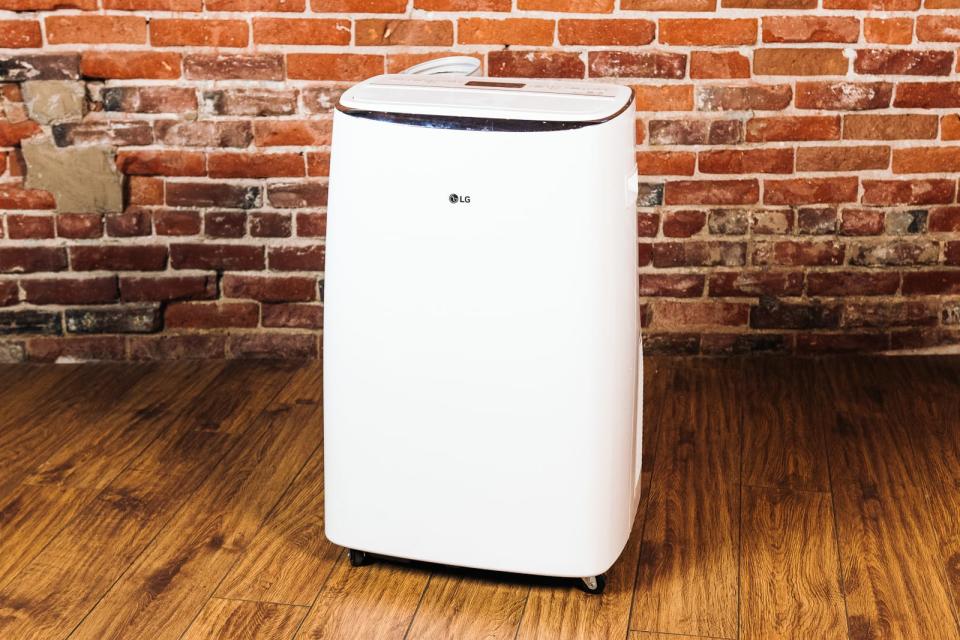
The LG LP1419IVSM is the quietest and most powerful single-hose portable air conditioner. It's also the most effective, with a high energy-efficiency ratio, and does a better job overall at achieving and maintaining a desired temperature and humidity level regardless of the weather or room conditions. That's because the LG is literally operating under a different mechanical process than your typical air conditioner: it uses a DC-powered, dual-rotor compressor rather than an AC motor with a single rotor like most other models.
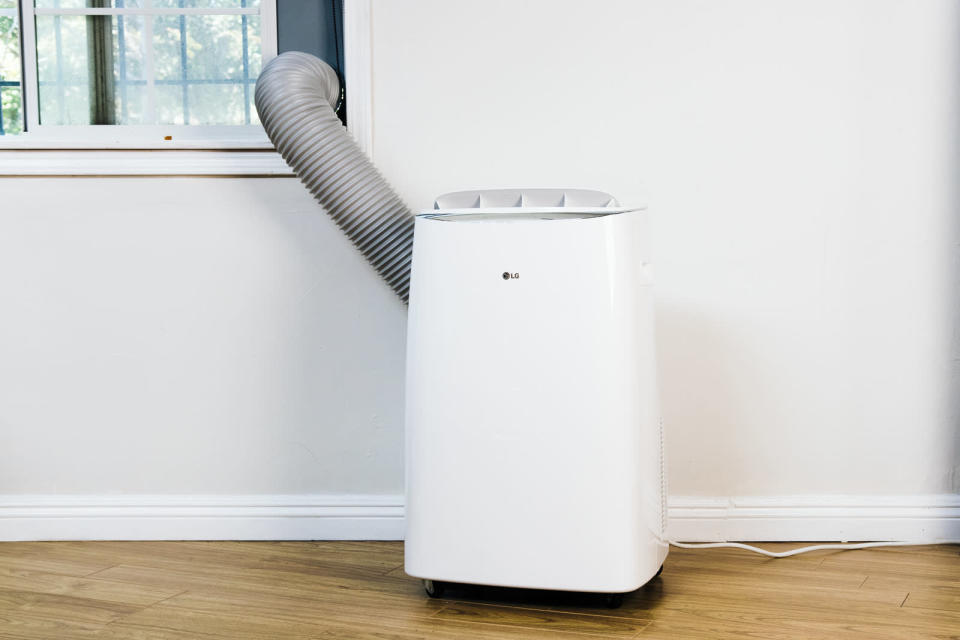
While most compressors run on only two speeds—on or off—the LG's variable-speed rotors can adjust to more precisely match the cooling requirements of the given conditions without any huge spikes in energy consumption. As a result, it's better at cooling spaces than other models with the same power output and will save you money on your electric bill in the long run. This difference clearly shows in the changing standards for measuring the power output of portable ACs. According to the old ASHRAE standards, the LG has 14,000 Btu of power, just like most of the other models we tested. But using the more comprehensive SACC performance standards, which measure across conditions, it achieves an impressive 10,000 Btu per hour. By contrast, the other models we tested only reached SACC scores between 7,200 and 8,500, and there were plenty of other 14,000 Btu models that ranked even lower than that. So even though these units all had the same basic power-output level, the LG's compressor setup meant that it used that power output more effectively.
The LG's unique compressor design also means that it operates more quietly than other models. The biggest difference is the absence of the audible "Clunk! Bu-zzz-ZZZ" sound you'd recognize from any air conditioning compressor as it fires up. There's also a smaller difference in the sound the machine makes with the compressor off, versus on, than we measured in other units. With the LG's compressor on and the fan running on low, we measured it at 56 dB from about 5 feet away—the same as the Whynter and a little quieter than the Frigidaire or Honeywell models we tested. With the fan on high, the LG's volume went up to only 60 dB—by comparison, the Black+Decker started at 64 dB with the compressor on and the fan running low, and hit 66 dB on high. (Without the compressor, the Black+Decker's volume dropped by about 10 decibels.) When we measured the frequencies of the LG's sound output, we noticed a few tiny spikes in the higher range—between 9,900 and 10,500 Hz, and then between 14,500 and 15,000 Hz—but it didn't bother us enough to notice.

The LG's swinging fan pops up from the top of the unit and automatically oscillates to help spread the cool air around the room. It actually works, too: in our tests, the LG showed the most consistency in temperature measured from 5 and 15 feet. This fan affects the way that the already-quiet LG sounds in the room, as the volume falls and swells in waves, giving it a gentle, breath-like timbre that easily fades into the white noise of the background.
The single exhaust hose is also built directly into the LG's rear side, in a design that can be compressed like an accordion in a vertical orientation that sits nearly flush with the unit. This is easier to manage than with the hoses on other models we tested—some project awkwardly out of the back, perpendicular to the unit, and/or are completely detachable, so they must be stored separately and can be misplaced.

The control panel and display on the LG are large and easy to navigate, although they can be hard to see. Like the other models we tested, you can set it to dehumidify (without cooling) or just run it in a fan-only mode. Its drain ports work like the others as well—they can screw open when it's time to empty the unit of condensation, and they're awkwardly low, like the others, ensuring you do this task as infrequently as possible. As with other portables, the LG's filters are easy to remove and clean without any additional tools. The remote control is standard, and the unit has a convenient recess on the back to store it (along with the plug end and maybe the manual) at the end of the season.
The LG also has smart capabilities that allow you to control it via smartphone, SmartThinQ, Amazon Alexa, or Google Home. Although this didn't make or break our pick, it's a nice feature to have and allows you to schedule air conditioning times or turn the AC on when you're away from home.
Flaws but not dealbreakers
At 78 pounds, the LG was the heaviest model we tested. The caster wheels and handles make it easy enough to move around on flat areas. Carrying any portable AC up and down stairs is a challenge; the LG's added heft amplifies that problem.
The LG has only a single drain port on the back for the moisture it extracts from the air, while other models we tested (with the exception of the Black+Decker) had a separate drain for the dedicated dehumidifier mode that was more accessible. This unfortunately means that you may need to lift the unit up and tip it over in order to pour the water out—which could be difficult if you let it fill up to its 20-gallon capacity.
The LED temperature readout can be hard to see in daylight. Direct sunlight through windows made it nearly illegible a few times during our tests. You have an option to dim this screen—great for night use, which is a bigger concern—but ideally it'd always be readable.
The window installation kit is pretty consistent with those of other models—a manageable job involving screwing two panels together to make a rough seal in the open window. We would have begrudgingly accepted this as the standard but after seeing the far-superior window kit on the Frigidaire, we think that LG could have probably come up with a better system for such an otherwise exceptional machine.
Several owner reviews (mostly on the Home Depot site) complain that the compressor on the LG emits a loud, high-pitched whine that sometimes makes it difficult to sleep. Although we didn't hear anything like that in our own tests, we did measure a small spike in volume that occasionally popped up around the 9,900 to 10,500 Hz range, and then again between 14,500 and 15,000 Hz. This is pretty high up in the human hearing range, but it could account for the problems that some people have encountered. Most adults won't notice this noise, however.
Also great: Frigidaire Gallery 12,000 BTU Cool Connect Smart Portable (FGPC1244T1)
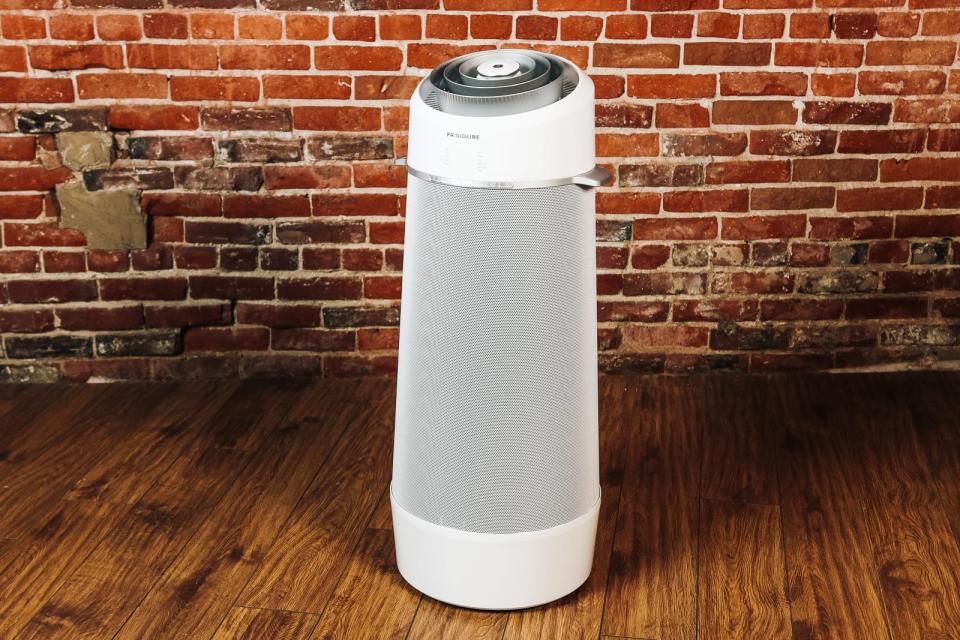
The Frigidaire Gallery 12,000 BTU Cool Connect Smart Portable (FGPC1244T1) isn't quite as powerful or pleasantly quiet as the LG but it has a unique design with a lot of thoughtful details that greatly enhance the overall user experience. It was also the only model we tested that didn't require any tools to set up—not for the window panel or the filters.
The Frigidaire had the highest energy-efficiency ratio of any single-hose model we tested, at 11.0. But it also had a lower SACC (7,200) and Btu (12,000) rating. In our tests, it made a noticeable dent in the temperature on a warm LA afternoon in just 15 minutes, suggesting that it uses that slightly lower power output efficiently and effectively enough, and the EER number backs that up.

The Frigidaire is taller and narrower than other portable ACs, which is nice for two reasons: it takes up less floor space in the room and you also don't have to bend down as far (or at all) to move it or to access the controls. In fact, it might be the only portable AC in history that owner reviews have praised for its good looks. While most portable ACs look like a beat-up old R2 unit sitting in the corner of the room, the Frigidaire looks more like a pawn from a futuristic chess set. At 66 pounds, it's also lighter than other models we tested, although the design means that the weight sits at the bottom of it in a way that makes it easier to roll than to lift.
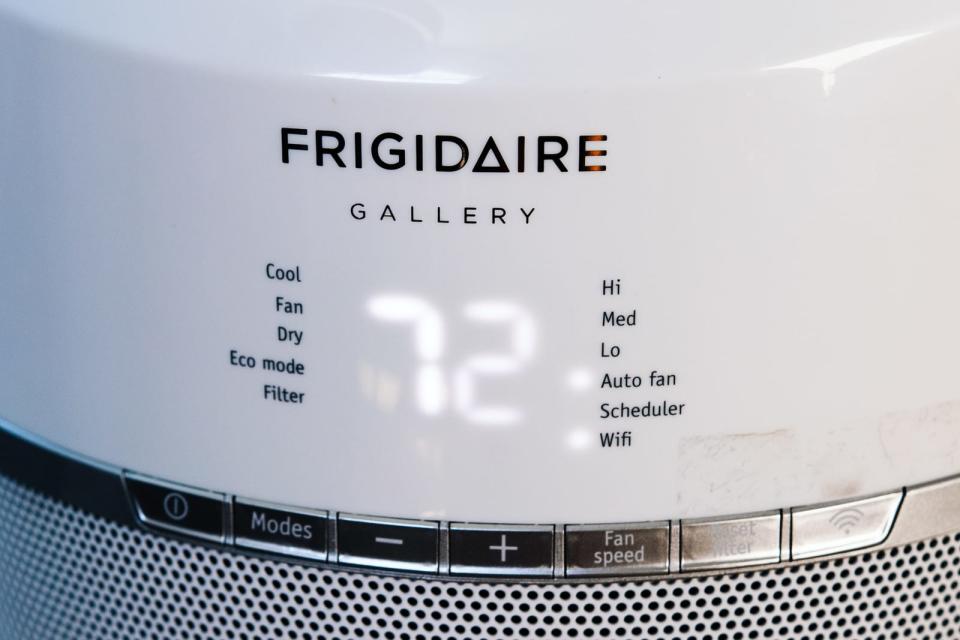
Part of what makes the Frigidaire's design so remarkable are the thoughtful details that went into it. Where other portable ACs have the same unattractive accordion-style exhaust hose, for example, the Frigidaire includes a cloth sheath to cover that eyesore and provide a little insulation. The unit also has a magnet on top of it to store the remote control. Even the window panel is a noticeable improvement—instead of a collection of separate plastic plates that screw together, it's a single telescoping unit that locks into place without the need to fuss with tools, with built-in foam padding on either end. It comes with a special strip of tape to cover the extendable notches, too. These small but meaningful design choices help make the Frigidaire easier to live with—which is not something you'd say about a lot of portable ACs.

The Frigidaire also boasts some of the same nice features as other portable ACs we tested, such as smart-home capabilities via Amazon Alexa, Google Home, or the Frigidaire smartphone app. This app has a built-in scheduling feature, too, but this is accessible only through the smart features and not directly on the control panel or with the included remote control. Like the LG, the Frigidaire also has a dedicated dehumidifier mode, but the Frigidaire improves on this by using a separate drain for that mode that can attach to a garden hose to draw off the water.

The only downside of the Frigidaire is that the compressor makes some, erm, different sounds than what you'll typically hear with other portable ACs. It's not particularly loud overall—57 dB with the compressor on and the fan on low (about the same as the LG), although it can jump to 65 dB with the fan on high sometimes. However there are some occasional peaks around the 1,500 Hz to 1,600 Hz range, like the teacher's voice from the Peanuts cartoon, that can be kind of annoying. Other times, it emits a higher-pitched rattling sound around 4,000 Hz or a strange hiss and gurgle when dehumidified air is draining. None of these noises are consistent or overwhelming but they do happen sometimes.
Also great: Honeywell HL14CES
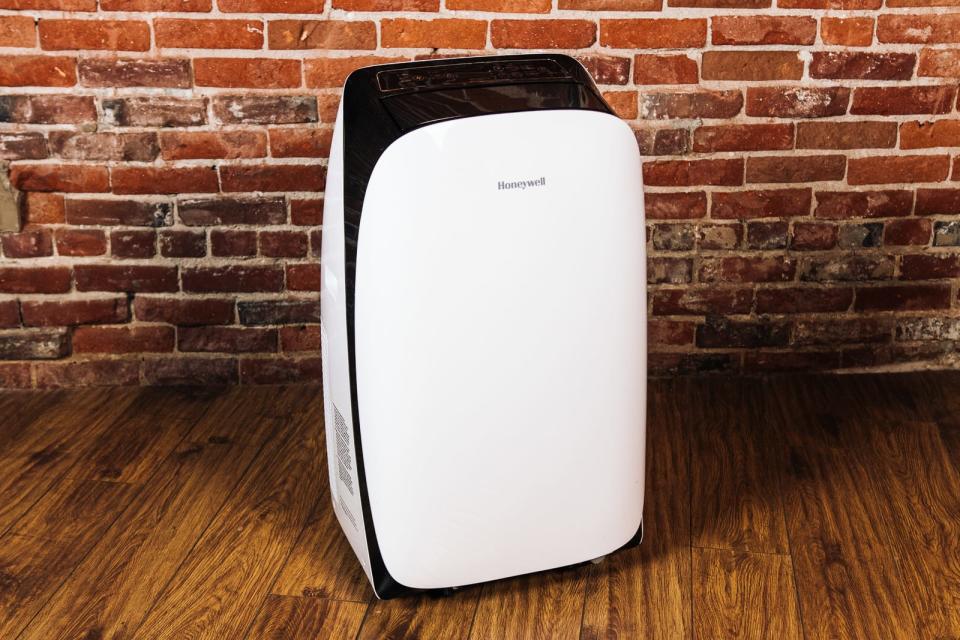
The Honeywell HL14CES is a really solid and effective portable AC, even if it doesn't have the same fancy design features as Frigidaire or cutting-edge compressor technology like the LG. With a SACC rating of 8,500, it had the second highest power output in our group after the LG. The temperature display on the control panel was also easier to read, with big, bright numbers that were legible across the room, although it doesn't have any smart-home capabilities.
At 76 pounds, it was one of the larger models we tested—second only to the LG—though it's easy enough to move around. And though other units like the Frigidaire and the LG were slightly better at dispersing their cooling and dehumidifying evenly throughout the room, the Honeywell was still pretty good.

In our tests, the Honeywell was only about two decibels louder than the LG with the compressor on and the fan running low, and about the same volume with the fan on high. However, we did measure a weird peak around 4,600 Hz, which is around the top of the human voice range and could get annoying for some people.
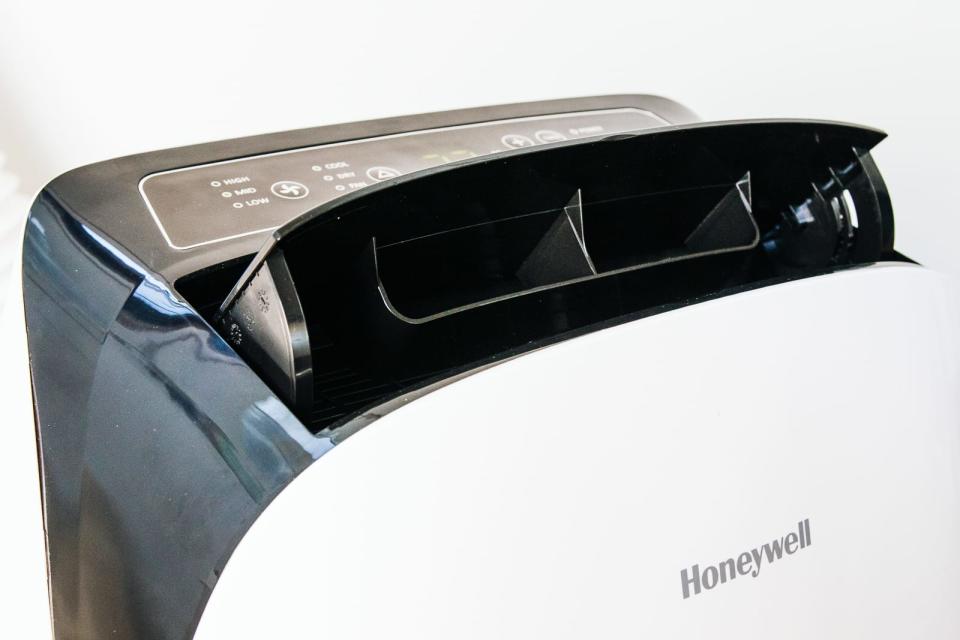
The Honeywell doesn't require any tools to assemble the window panel like the LG did; the panels snap together easily, which made it slightly more convenient than other models besides the Frigidaire. However, you do need a Phillips-head screwdriver to remove one of the Honeywell's two filters for cleaning. Like many portable ACs, this model also has a separate, dedicated dehumidifier mode, but it's a touch more convenient than most: A separate spigot for the dehumidifier mode can attach to a standard garden hose for easy draining.
Budget pick: Black+Decker BPACT14WT
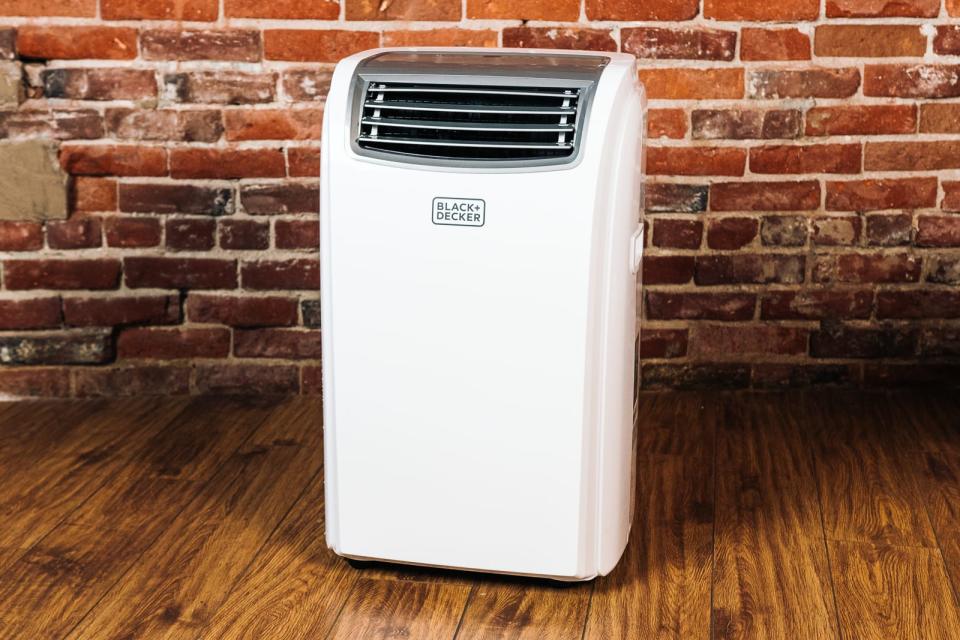
The Black+Decker BPACT14WT is loud and clumsy, and yet it's your best bet for a cheapish portable air conditioner that will actually get the job done. We had limited our search to models with an energy-efficiency ratio of at least 9, and a seasonally adjusted cooling capacity of 7,200, and the Black+Decker just made the cut on both metrics, with an EER of 9.86 and a SACC of 7,500. While this was the most affordable option we tested, plenty of more expensive models didn't even reach our threshold for power and efficiency.
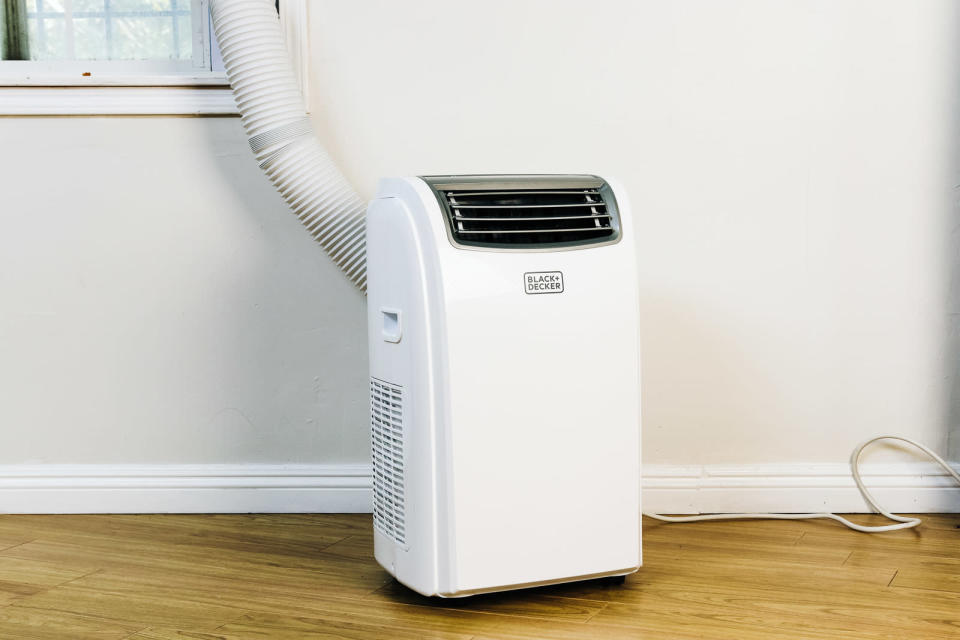
In our tests, the Black+Decker's condenser started at 64 dB with the fan running low—about 8 dB louder than the LG or Frigidaire—and reached about 6 dB louder than the LG or Honeywell at its top volume. It also emitted the most uneven range of frequencies. We measured peaks around 100 Hz (like the low end of a guitar) and then again at the high range of 4,500 Hz, 5,500 Hz, and 9,000 Hz (like a bunch of cymbals and sibilant "s" sounds). This is great if you enjoy listening to an amateur White Stripes cover band with a snake on lead vocals, but it might not be the best if you want to sleep or get any work done. Full disclosure: when I was measuring these frequencies with the Black+Decker running in a small, closed room, I got a headache after 15 minutes.
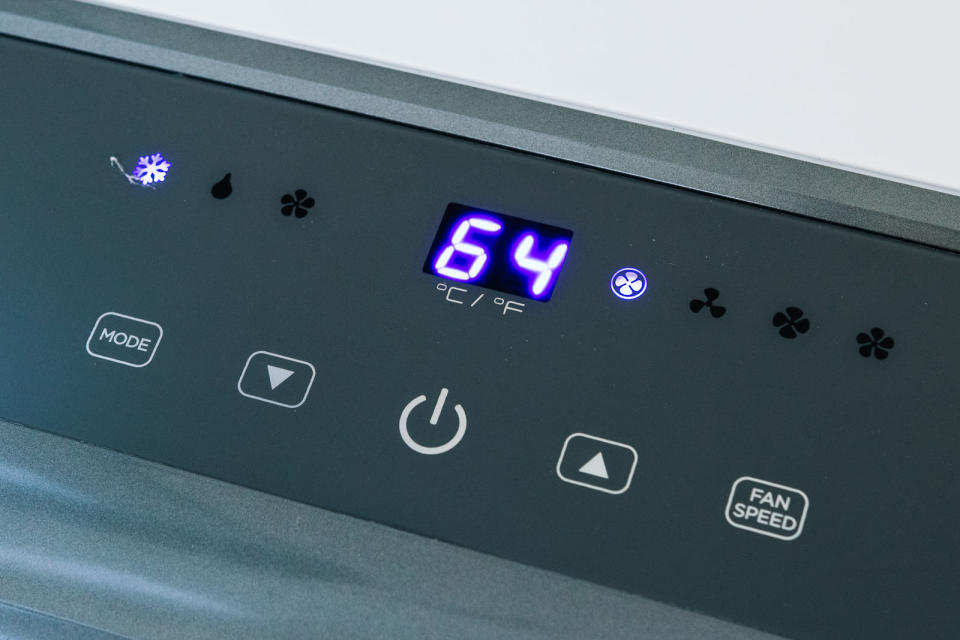
The Black+Decker isn't hard to set up or maintain, but you do need a screwdriver to install the window panel or remove the filters. This isn't terrible but it's also not as easy to deal with as with the Frigidaire or LG models we tested. The haptic control panel is easy enough to use, which means you can just touch the buttons instead of actually pushing down on them—although there's no real feedback to let you know if you've actually activated the button or not. They also look like push buttons, and if you follow your instincts to push them—or if you're not sure they responded to your tap and you push a little more just to triple-check—the whole control panel bows down slightly along with your fingers.
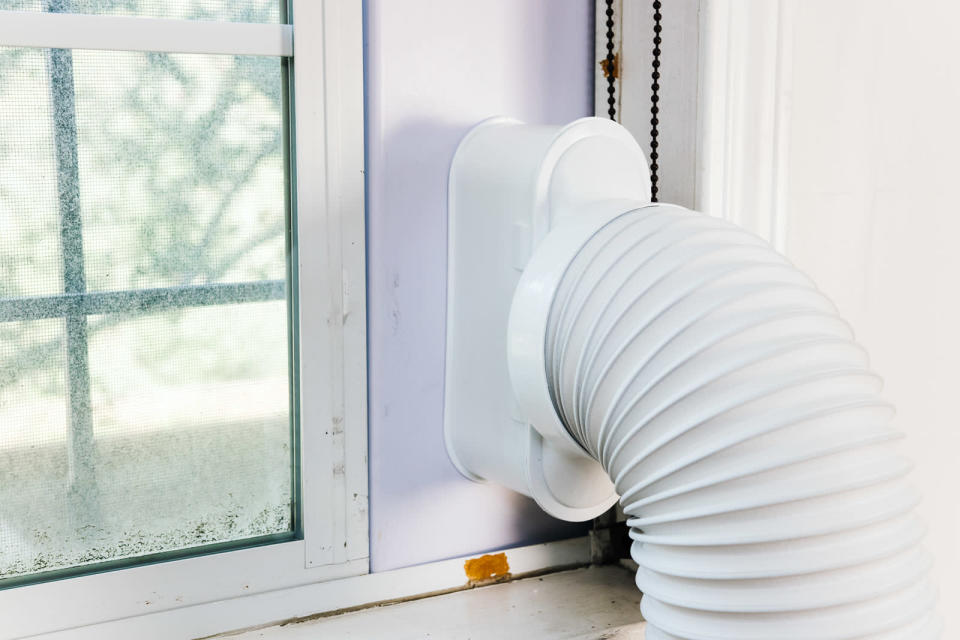
The Black+Decker was the second lightest model we tested, at 68.3 pounds. It has rough, bumpy casters that felt cheaply made but they work well enough.
What to look forward to
In 2016, the Department of Energy approved a rule that would require all portable ACs to use at least 20 percent less energy than the least efficient models that are currently available. It was scheduled to be added to the Federal Register in March 2017, but the current administration delayed that step. In 2018, a district judge ordered the standards implemented, but then another court allowed the delay to continue just a few months later. As of this writing the standards remain in limbo. If this rule is finally solidified, the new efficiency standards will take effect in 2021. Meanwhile, manufacturers have already started adopting it.
Even with the new regulations, most portable air conditioners will use more energy and provide a worse cooling experience than window air conditioners. Several groups advocated for even stronger standards. But as Lauren Urbanek, senior energy policy advocate for the Natural Resources Defense Council, put it: "We're happy that there's a standard to begin with. These products were very far behind window AC efficiency and using way more energy than they needed to."
The competition
The Whynter Elite ARC-122DS used to be our top pick. If you absolutely want a dual-hose model, this is the one to get. After taking another look at it this year, it's still a great portable air conditioner, but we didn't think the cumbersomeness of the second hose really added enough to the efficiency or experience to set it apart for most people. (If you live in an area that frequently gets above 95 degrees or so, a dual-hose model might be worth using, according to one DOE study [PDF].) At only 57 pounds, the Whynter is surprisingly compact, and it's pretty quiet, too, though not as quiet as our other picks. The Whynter Elite ARC-122DHP is another former pick that's essentially the same, with the addition of a built-in heater.
We didn't retest our former also-great pick, the Haier HPND14XCT, because it often suffers from stock issues and didn't reach the SACC power threshold we were looking for this time around. In a previous version of this guide, we had also dismissed the dual-hose Avallon APAC140C, which was too bulky and too inefficient with its energy use; and the Whynter ARC-14S, which was our also-great pick in 2016 but is just too loud.
Other 14,000 Btu models we considered and dismissed this year include the Toshiba RAC-PD1411CRU, NewAir 14,000 BTU Portable AC, JHS A018-14KR/C, Emerson EAPC14RD1, Honeywell HL10CES, and LG LP1417GSR. We also wrote off the Shinco SPS5-10C, Frigidaire FFPA1022U1, Della Portable Air Conditioner, Rosewill RHPA-18002, Honeywell MN12CES, Friedrich PH14B, and SPT WA-1351DE all without a second glance because they just weren't powerful enough. We previously dismissed another three dozen dual- and single-hose models from CCH Products, EdgeStar, Friedrich, Haier, Emerson, Frigidaire, and Sunpentown, and others due to shaky reviews, concerns over specs like noise and efficiency, and price and availability issues.
Care and maintenance
The most important thing to do to make a portable AC perform at its best is to insulate the gaps between the window, window frame, and the panel holding the AC vent. Foam strips work, and 10 feet of the stuff typically costs a few dollars. The tape will help prevent warm air from slipping in through cracks as easily.
When using the AC, keep it as close to the window as you can, with as many of the accordion ribs collapsed as possible, so the hose is as short and straight as possible. Clean the filter at least once a month.
This guide may have been updated by Wirecutter. To see the current recommendation, please go here.
When readers choose to buy Wirecutter's independently chosen editorial picks, Wirecutter and Engadget may earn affiliate commissions.
